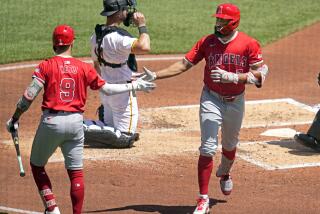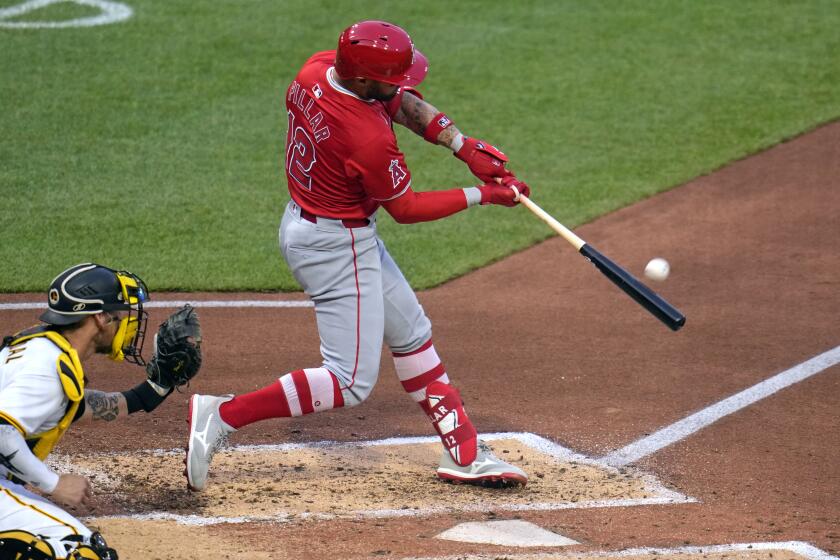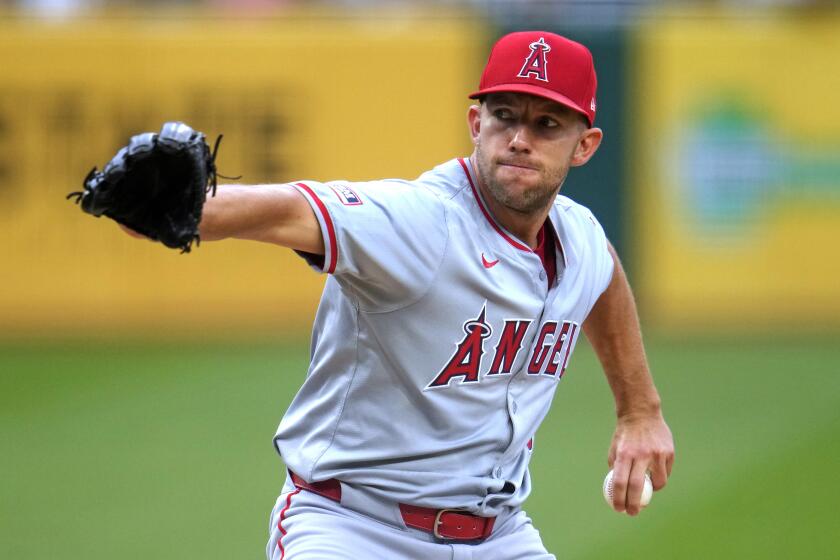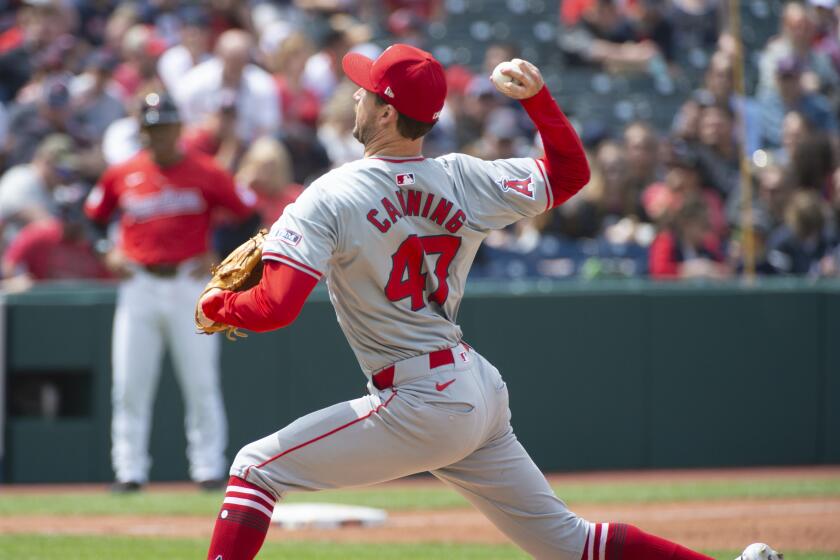Reading Between the AngelSpeak
OK, let’s see if we have this straight. The Angels’ game plan for the winter ahead is to:
a) Sign Bobby Bonilla.
b) Sign Danny Tartabull if they can’t sign Bobby Bonilla.
c) Re-sign Wally Joyner if they can’t sign Bobby Bonilla or Danny Tartabull.
d) Resign from the American League if they can’t sign Bobby Bonilla, Danny Tartabull or Wally Joyner.
Actually, it’s not quite that simple. With the Angels, when is it ever?
Actually, what the Angels need to do is to sign Bonilla and Tartabull and Joyner--and then they might be started in the right direction. Do that and the Angels would be left only with holes to fill at catcher, center field, fourth starting pitcher, fifth starting pitcher and middle relief pitcher.
This, of course, is the strategy the Angels have chosen after their 347th declaration during the past 18 months that they plan to “build from within.” Listen to them now and believe them later. For a long while, this inconsistency in Angel think-and-do used to annoy me, but that was before I cracked the code of AngelSpeak.
Building from within, traditional definition: The drafting and acquisition of young prospects for the purpose of developing them within one’s minor league system, thus establishing organizational stability.
Building from within, Angel definition: Seeing what’s within Gene Autry’s billfold and seeing how much of it can be spent.
The Angels always believe they’re one or two free agents away, and now they believe those free agents to be Bonilla and/or Tartabull. In the next few days, they are set to lay $28 million or so in front of Bonilla, erstwhile outfielder for the two-time NL East champion Pittsburgh Pirates, to see if he’ll bite at an admittedly unique career opportunity--a chance to go from first to worst, with one swing of the pen.
But first, the Angels have a problem.
Bonilla wants to see what the Angels do with Joyner before making a decision.
And Joyner wants to see what the Angels do with Bonilla before making a decision.
Catch-22 used to be the punch line to an old joke about Luis Polonia and 100 fly balls, but no more.
Understand where Bonilla’s coming from--a team used to winning--and where the Angels want him to go. The Angels finished last in 1987 and 1991, a distant fourth in 1988 and 1990--and did it all with Joyner at first base. If Bonilla comes and Joyner goes, what’s the point, where’s the improvement? The Angels need to eliminate their weaknesses, not exchange one strength for another.
Consider, too, Joyner’s temporary position. He has done his time in Anaheim--six long years, too many contract negotiations that turned into Texas steel-cage matches, too many seasons of straining to maintain a profile higher than the riffraff around him in the lineup. Finally, parole has been granted. If Joyner wants to look around, do lunch, see how high the dollar signs can climb, he has earned the right.
So where could Joyner go from here?
St. Louis seemed the most logical destination, with a manager Joyner knows and likes (Joe Torre) and Astroturf-lined outfield alleys he would like to know better. But the Cardinals have grown weak in the knees in the face of the probable price tag: four years, $16 million.
Atlanta is home for Joyner; he was born there 29 years ago. Unfortunately, first base is also the home for too many Atlanta Braves--Nick Esasky (vertigo willing), Sid Bream (knees willing) and Brian Hunter (Bobby Cox willing). The New York Mets have shown interest, but when Wally thinks of New York, he usually thinks of the hunter’s knife that landed at his feet while he was walking off the field after a game at Yankee Stadium.
The Dodgers? Still a possibility, although the Dodgers would prefer a right-handed hitter at first base and are prepared to settle for a stopgap there until prospect Eric Karros is ready, if and when. Besides, judging from Darryl Strawberry’s true feelings about close-and-personal friend Kal Daniels, first base is down a ways on the Dodgers’ list of pressing concerns.
If the Angels re-sign one of their own free agents for 1992, Joyner is the one. Kirk McCaskill and Dick Schofield are coin tosses. McCaskill went 10-19 in 1991 and cost the Angels $2.1 million--not much of a return, Whitey Herzog has noted--but in his five injury-free seasons with the Angels, he won 12 games twice, 15 once and 17 once. McCaskill turns 31 in April. Schofield is a nice little shortstop, but no more of an offensive threat at 28 (.225, 0 home runs, 31 runs batted in) than he was at 22 (.219, 8, 41). Maybe it is time for Gary DiSarcina. Whatever DiSarcina can or can’t do with the bat, it can’t be much worse.
Joyner is the keeper in this lot. He is not the franchise player the Angels thought they’d lucked into after the home-run mirages of ’86 and ‘87; he’s more Mickey Vernon than Mickey Mantle. But Joyner is a player who will make your franchise better, even pennant caliber, provided he’s surrounded with enough protection in the batting order.
Bonilla qualifies as the right kind of protection. He batted .302 with 100 RBIs in 1991, but he did so with Barry Bonds in the same lineup. To do it again, in Anaheim, he’ll need Joyner in the same lineup.
It doesn’t work, one without the other, as the Angels ought to have learned last season when they signed free-agent third baseman Gary Gaetti but forgot to re-sign free-agent designated hitter Chili Davis.
Bring two pens into the hunt--one for Bonilla, one for Joyner. Sign them both. Sign them side-by-side, at the same table, if need be.
Quite understandably, this is one plunge no one wants to take alone.
More to Read
Go beyond the scoreboard
Get the latest on L.A.'s teams in the daily Sports Report newsletter.
You may occasionally receive promotional content from the Los Angeles Times.





